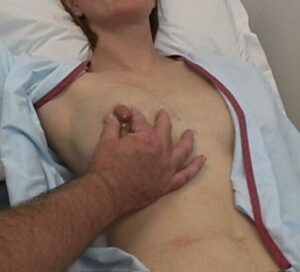Normally, if the ducts are stripped toward the nipple, a drop or two of clear, milky, or greenish-tinged liquid will appear. This is not considered nipple discharge.

Nipple discharge (milk)This image demonstrates milk from a lactating woman. This is also considered normal.
If the nipples spontaneously leak discharge, staining the clothing, that is not normal, nor is it normal to have bloody nipple secretions.
Nipple discharge from both breasts indicates “galactorrhea.” While a few post partum women will continue to leak small amounts of milk for years following delivery, galactorrhea in general indicates the need for a serum prolactin measurement and possibly an MRI of the pituitary gland to look for prolactin-secreting pituitary adenomas. Hypothyroidism can also cause this problem, although it is rare.
Athletes may experience small amounts of galactorrhea from constant rubbing of the nipples against clothing. Frequent sexual stimulation of the breasts may have similar effects. The serum prolactin measurement is best made after a few days of non-stimulation of the breast. Even after a breast exam, it is often helpful to wait 2 days before measuring the serum prolactin.
Persistent discharge from a single duct, particularly if bloody, rust-colored or multicolored, suggests the presence of an intraductal lesion, such as an intraductal papilloma. While these are often benign, they need further exploration with a general or breast surgeon.
